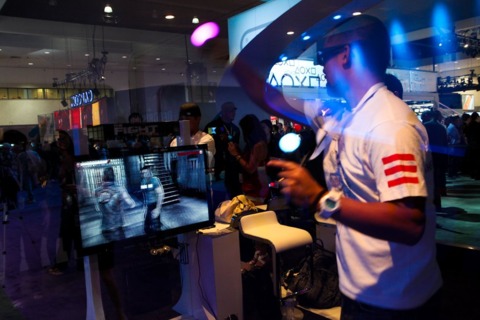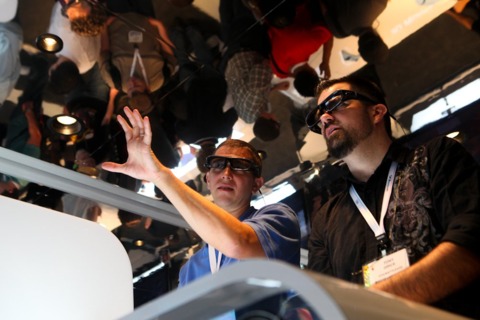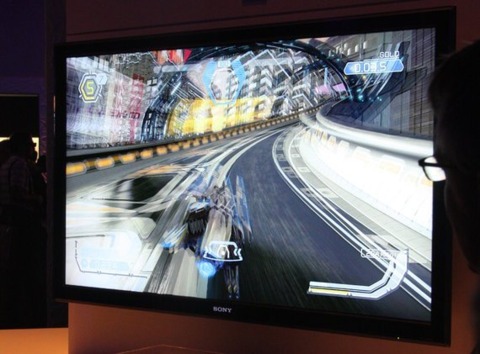'Gamers will drive the 3D movement' - Sony 3D game head
Gamescom 2010: SCEE senior director Mick Hocking explains why the market will get over the glasses and embrace the third dimension on the PS3.
COLOGNE, Germany--This year started with James Cameron's 3D blockbuster Avatar crushing box-office records and setting off a 3D craze in the film industry. The gameworld has also hopped on the 3D bandwagon, with Nintendo unveiling its innovative three-dimensional portable, the 3DS, at June's Electronic Entertainment Expo.
Sony's own 3D efforts have been substantial this year as well. The company released a line of 3D-enabled televisions, and in June unleashed a firmware update that allows all PlayStation 3s to play select games in 3D. And looking forward, PS3-exclusives Killzone 3 and Gran Turismo 5 will feature 3D support, allowing anyone with a special TV access to the stereoscopic gaming view. 
GameSpot caught up with the Sony executive in Germany at Gamescom 2010 to talk about the company's recently launched line of 3D-enabled televisions and 3D gaming efforts. Hocking discussed everything from how his company aims to bring 3D TVs into consumers' living rooms, to why they should be there, to how gamers are going to pave the way.
GameSpot: How do you view the market currently considering that a lot of people have just invested in an HDTV within the past couple of years?
Mick Hocking: I think that's a good point. From our point of view at PlayStation, we think games are probably going to be the killer content for 3D, one of the big market drivers. I think this year is year zero for 3D in the home. We've launched the TVs this year, all the PlayStations out there are currently upgraded to support 3D gaming, so that's potentially 36 million PlayStations out there that can play 3D games. But of course we need people to go purchase 3D TVs. So our job at the moment--as is the job of the sports broadcaster, the film industry, and other industries--is to get people to purchase 3D TVs.
It is a challenge because people have been buying HDTVs the past five years, so it's really crucial that we can deliver experiences which are good enough and compelling enough to make people make that purchase decision and upgrade to a 3D television. And I think what's encouraging is it's not just the games industry that's pushing it. Obviously we have 3D Blu-ray movies coming, and a lot of them in production, so the next few years you're going to see an awful lot of 3D movie content as well as a lot of great 3D games. We have more than 20 3D titles coming out in the next 12 months, and you'll see that [figure] grow rapidly. But also I think there are other drivers.
Sports is going to be a big factor. Companies like Sky are now really getting to grips with how to deliver 3D sports content, and that's going to be huge. Once people see sports well in 3D, that'll be a big driver for purchase decisions. And I think in addition to that there's also personal content. You're going to be buying a 3D camera, the next time you buy a digital camera. Camcorders are coming out, so you'll be taking movies of your family in 3D, and you'll want to view all this content at some point on a TV. So I think we're going to see it grow and grow and grow over the next few years.
GS: Is it fair to say Sony's current involvement in 3D is sort of an investment in the technology? So that when the TVs do become more common you guys have a vast track record to draw from in terms of game development?
MH: Yeah. I think one thing that's unique about Sony is that we're the only company in the world that has the entire hardware and software chain for 3D within our core business. We are making a big investment into [3D] and we do believe 3D is going to be very popular and will be a growing technology. But it also means that with our 3D games team that we have in the UK, we look after all of the 3D worldwide. But we talk to the guys in Sony Pictures a lot about the latest techniques, the latest technical solutions, in 3D. We talk to the guys in cybershop, we talk to the broadcast areas of the company, and because we're doing that we can pool our knowledge and experience and make sure the content that we produce is at the highest possible quality. 
We're driving the message very hard to produce high-quality 3D content. It's not just adding depth to what you're seeing. It's a new creative medium, it needs to be understood, it needs to be worked with to get the very best from it, and I think Avatar so far in the movies has shown that if you do great quality content, people will love it and they will come back for more. And we're doing the same with games; that's our angle at the moment.
GS: What does adding 3D to a game mean in terms of added cost? Is an independent developer working on a PlayStation Network downloadable game going to be able to develop in 3D anytime soon?
MH: Yeah. I think Super Stardust HD was a good example of that. Small team, really talented guys. But they put their game to 3D, one of the first teams that we worked with and they have produced a stunning effect. Super Stardust looked incredibly good in 3D. I think retrofitting 3D is harder than building from the start as you'd imagine. Because you've already made decisions about a game and then you're trying to do something different with it. In terms of getting the 3D element into the game, if you build that in from the early stages of the game it's not that difficult, it's not that significant in terms of cost for the dev team.
There are other areas for 3D which need to be taken into account. You need to test games for 3D. So you need to train up your QA team to look for problems that appear in 3D. If you go into market and your game is 3D, your marketing services need to produce 3D content. So there are things around 3D game development that need to be looked at. So far, even some of the big complex games have proven not that difficult to get 3D working within them.
GS: Do you advise against adding 3D late in development, as opposed to making it a part of the game from the start?
MH: We wouldn't advise against. In terms of optimization, and perhaps changes to the scene, it's easier to make those decisions earlier on. But you can do it, you can add 3D pretty much at any point. It's just the amount of rework you might have to go and do. So we would advise teams to consider 3D early on. And also with every team we work with, once we sort of educated them about the basics of 3D, and the benefits of 3D, we ask them to consider how it can enhance their game. 
There's no point in adding 3D to a game if it doesn't do anything. It needs to produce a new effect, or a new immersion or something. So it's really down to the developer to consider what 3D is going to do for their game. And I think we have 20 titles already but obviously some studios who are very late on the development and have got very packed schedules may make the decision to not add [3D] right now, but you may find the next game they make will have [3D] in it.
GS: How does 3D affect the system resources of the PS3? Can a game be reasonably expected to run in 3D at 1080p as well as offer Move support?
MH: The highest resolution we do, with games, is 720p. We do 1080p at 24Hz with movies. Essentially the cost of 3D is like doing two-player split-screen. All you're doing with 3D is rendering two scenes: one for the left eye and one for the right eye. So, beyond that, there's some creative stuff you need to do with the game. But that's really the cost of it. It's not a cost that developers haven't experienced before. That's purely an optimization: can you do two scenes? If you can't, you need to be able to optimize the game to be able to do that. But above that it doesn't really hit the system anymore.
GS: In terms of your personal experience, does 3D suit one particular visual style or game genre better than the others?
MH: No, we've converted quite a lot of games to 3D from different genres and we've found it enhances just about all of them. You can imagine a game that's being designed to be 2D may not lend itself to 3D, but certainly racing games, sports games, benefit a great deal from the addition of 3D. Action games and first-person shooters look great in 3D. Pretty much everything we've tried so far looks better in 3D. How it affects games is different in the particular genres, you get different benefits. But I think visually they're all enhanced and most get enhanced gameplay from the addition of 3D.
GS: Can you go into detail about specific gameplay benefits in certain genres?
MH: In something like sports games…timing and judgment in sports games is really what it's all about, and having that finesse of control. So the first thing that 3D does, in any game, is provide you more information in the scene. Your eyes are seeing twice the number of pixels and of course you've got depth which your brain is processing for free. So in a game like MLB we've found it's much easier to judge when to swing the bat and hit the ball in 3D than it was in 2D. Because you're viewing it in the way you're normally used to viewing the world. You can see the ball approach, you can judge its speed, you can judge the timing of [the swing] that much more intuitively. 
And I think a similar thing is true for racing games. It's not a coincidence that most of the world's top drivers are now trained on 3D simulators. We've found in racing games--both arcade games and games like [Gran Turismo] simulators--you can judge the speed of your car, you can judge the braking distance to a corner that much better, you can judge your proximity to the car so that an overtaking maneuver feels that much more natural. You have more information to use and you can be a little bit more accurate about how you do it. All that tends to add up to produce a better lap time.
[It also helps] positioning things in games. So in something like Tumble, where you've got the Move controller, you're picking an object up and you're using the Move controller very accurately to go and place a block onto the stack. Typically, when we used to do that purely in 2D, we'd put a light source above so it would shine a shadow down, and as the shadow went across the stack of blocks you'd go "right, right, that's the right time to drop the block." But in 3D you can see exactly where the block is and it's completely intuitive so we don't need to do those sorts of tricks anymore. We can put the camera anywhere. So I think it enhances lots of games in different ways.
GS: On the flip side, are there any 3D elements to a game, where at the beginning of development it seemed like a great idea but in actuality it didn't work quite as well as the developer was expecting?
MH: We've not had any examples to date. We haven't seen any examples where 3D was added to a game and it made it worse. You have to understand the language of a 3D scene. It's different from the way a 2D scene works.
You interpret a 3D scene differently. So tricks that we used to do with racing games to make the car feel like it's going faster as you accelerated in 2D, we use slightly different techniques now in 3D because you get a sense of speed from the depth being there. We may choose a different type of camera, or we might position the car closer to the screen rather than pushing it away from the scene as you accelerate. But we've not found any areas where it's worse.
GS: Is it only Sony's first-party developers that you work with, or do you also work with third-party studios?
MH: The worldwide studios 3D team that I look after primarily works with first parties, but we also go through our third-party support. We've trained all those teams up and we directly work with some of the publishers of third-parties as well. But most of that, as you'd expect, comes from the third-party interface.
GS: In terms of glasses-free television sets, how far away are we from that technology? Years? Decades?
MH: I'd love to be able to give you an answer [laughs]. Currently, the best way of producing high-definition 3D on a TV is using either shuttered active glasses or polarized glasses. There isn't a good way yet of producing high-quality 3D on a TV without using glasses. Everyone asks us this question, "When can we get to the point where we don't need to put on glasses [to view 3D]?" We've not found anyone having a problem with wearing glasses so far--people wear sunglasses, people where glasses when they ride a mountain bike. If you're going to enjoy that experience, you put the glasses on while you're enjoying it. 
In particular, we find [gamers are] very accepting of new types of peripherals. Particularly if it can enhance the gaming experience. They're very accepting of that. I think for the foreseeable future, we're going to be seeing glasses-based technology, certainly for TVs. If somebody comes up with a glasses-free solution that is cost effective... They are out there. Sony has a cylindrical 3D screen, and it produces a great 3D effect, but it's extremely costly. There's nothing on the horizon. There's nothing we're aware of to be able to produce a good TV-based 3D at the moment without the use of glasses. I don't expect that's going to change in the near future.
GS: Are gamers really the ones who are going to adopt 3D first?
MH: What we're seeing at the moment is a technology convergence. It's the first time we've ever been able to have high-quality 3D on a TV set in the home. So I think gamers will definitely drive the movement. [Gamers] are natural adopters of new technology, and 3D really brings something new to gaming.
But I think there's going to be a huge wave of sports fans who--once they see high-quality sports content in 3D--will want a 3D TV just to view that, and they may be gamers or they may not be gamers. And I think you've got movie fans who are going to come on board as well. When you buy your 3D camera or your 3D camcorder, you're going to want to view that content on something. So I think you've got a wave of different technologies right across the spectrum of media that are producing 3D, and all of this is going to lead people to want to buy these screens at some point.
Got a news tip or want to contact us directly? Email news@gamespot.com
Join the conversation